Assessment and feedback in training and teachings
OverviewQuestions:Objectives:
What are the different types of feedback?
When do get and receive feedback?
For which purpose do we need feedback?
Requirements:
Describe the differences between formative and summative assessment
Explain why frequent feedback is important
Describe a few techniques for formative feedback
List a few techniques to cope with feedback on your teaching efforts
- Contributing to the Galaxy Training Material
- Principles of learning and how they apply to training and teaching: tutorial hands-on
- Design and plan session, course, materials: tutorial hands-on
Time estimation: 3 hours 30 minutesLast modification: Oct 18, 2022
Introduction
- Assessment: evaluation or estimation of the nature, quality, or ability of someone or something
- Feedback: integrate the output of the assessment in the learning process
Teaching goal for this session is to develop an understanding of different types of feedback,when to give and receive feedback, and for which purpose. By the end of this session, you will be able to:
- Describe the differences between formative and summative assessment
- Tell why frequent feedback is important
- List and describe a few techniques for formative feedback
The flowchart below highlights where the assessment and feedback phase falls in the overall Nicholls process (Via et al. 2020 and Nicholls 2002):
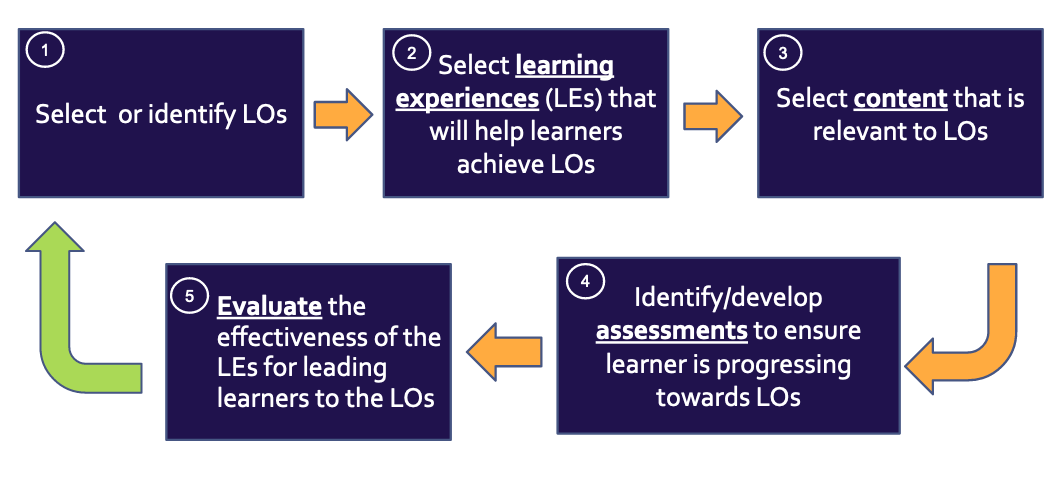
Assessments
There are different types of assessments:
| Assessment | Timing | Objectives |
|---|---|---|
| Pre-course assessment | Before the course | verify the target audience of the course |
| Preventive assessment | Beginning of the course | final adjustments of the course to the reality of the participants |
| Formative assessment | During the course | pilot in real time if learning is taking place |
| Summative assessment | Right after the course | measure and evaluate the knowledge and skills acquired |
| Strategic evaluation | After the course, long time after the course | measure the adequacy, quality and impact of the course |
and different ways that we can categorise them:
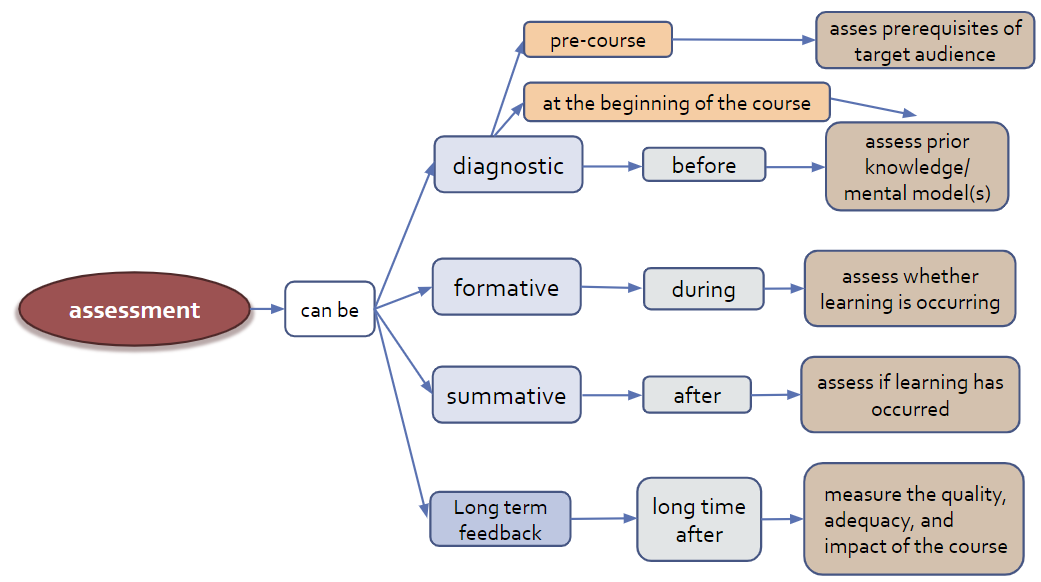
question Quiz: Diagnostic Assessment
Check your knowledge with a quiz!
- Self Study Mode - do the quiz at your own pace, to check your understanding.
- Classroom Mode - do the quiz synchronously with a classroom of students.
Formative vs summative assessment
-
Formative assessment takes place during teaching and learning. Its purpose is to help both instructors and learners to become aware of what the focus should be. Its purpose is to improve the quality of students’ learning, not to provide evidence for evaluating or grading students.
-
Summative assessment takes place at the end of teaching and learning. Its purpose is to evaluate learners’ learning by comparing it against a standard or benchmark, and provide evidence for evaluating or grading students.
Comment: At the end of teachingFor summative assessment, ‘the end’ does not necessarily mean the end of an entire course or module of study. Summative assessments may be distributed throughout a course, after a particular unit (or collection of topics) has been taught, but graded any how.
What are the methods for summative assessment? You do remember some of the methods used in summative assessment when you are a student (1-5) or from being a teacher:
- Questionnaires
- Interviews
- Observations
- Testing: specific test created by the teacher or establishment made to include all points of a unit or specific information taught in a given time frame
- Projects: a culminating project that synthesizes knowledge
Summative assessment should be
- Aligned to LOs (levels of complexity, what you taught, the level you taught it)
- Objective
- Feasible
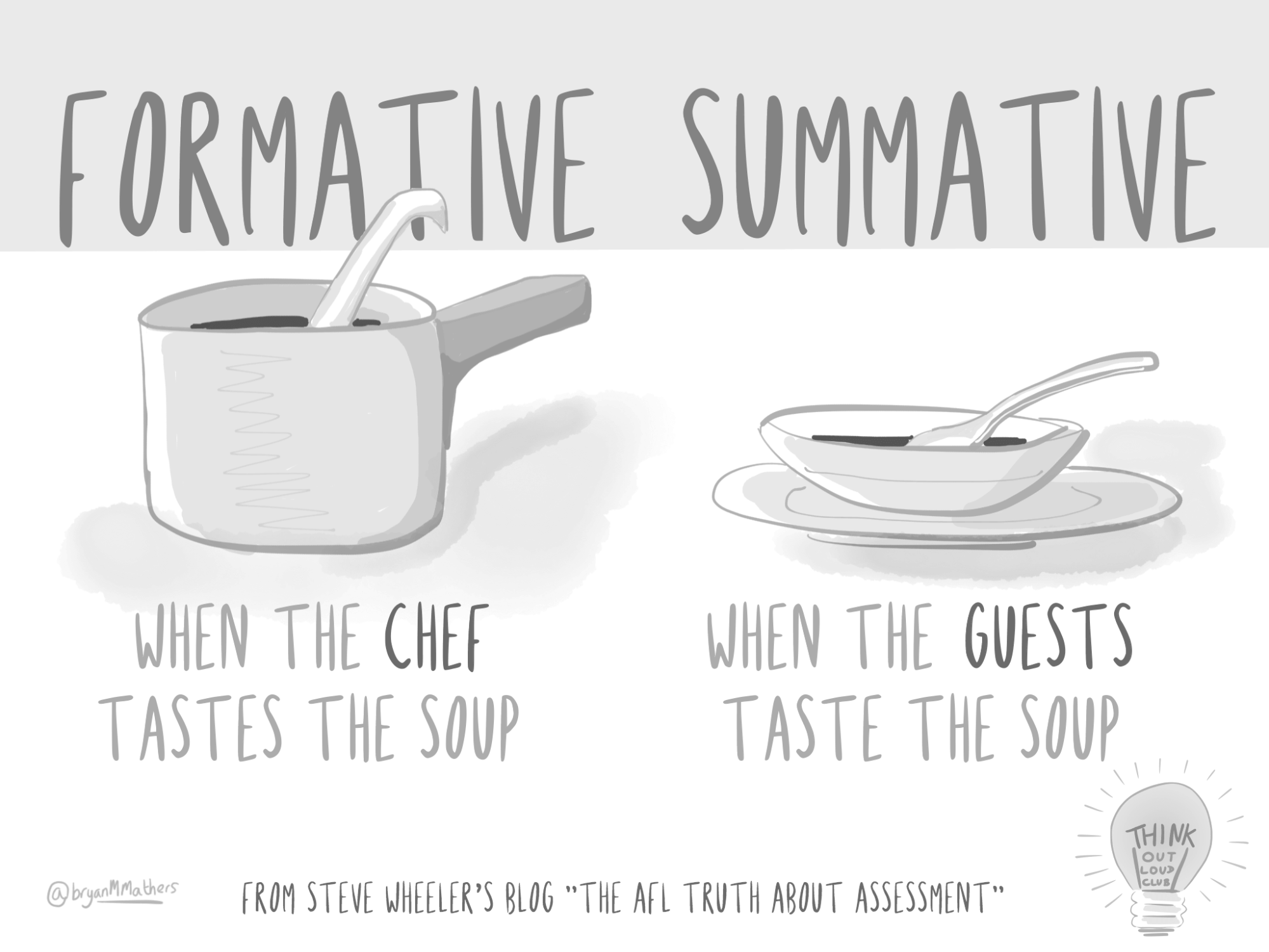
In training, the scope here, the focus is on formative assessment (collect information / feedback on how learning is progressing). We will from now on only talk about formative assessment.
Formative assessment takes place during teaching and learning. Its purpose is to help both instructors and learners to become aware of what the focus should be. Its purpose is to improve the quality of student learning, not to provide evidence for evaluating or grading students.
Formative assessment collect feedback (information) from learners’ on their learning progress :
- Goals and objectives: if learners goals and objectives are aligned to the course’s goals and outcomes
- Prior knowledge: which knowledge gaps need to be filled before moving on
- Mental models: whether their mental models are correct
- Frequent mistakes: which types of mistakes need special attention
- Ability to perform a task
question Quiz: Collecting formative assessment
Check your knowledge with a quiz!
- Self Study Mode - do the quiz at your own pace, to check your understanding.
- Classroom Mode - do the quiz synchronously with a classroom of students.
It should be highlighted that the best practice for teaching is to:
- Constantly monitor what is happening to students’ learning
- Investigate when things do not proceed as planned or expected
- Act upon to improve learning
- Provide feedback to learners on how to progress
Collecting data from learners through formative assessment
Formative assessment & feedback can be done in many different ways:
- Providing diagnostic questionnaires
- Asking questions to learners and getting responses orally
- Asking them to describe the strategy they would adopt to solve a problem
- Asking them to solve a problem in groups, or individually but in front of the class
- Using brainstorming and discussions
Diagnostic questionnaires
Questionnaires
Anonymous questionnaires allow to have an idea of the level of knowledge of the whole group of learners.Non-anonymous and personal questionnaires allow to find out if the learner has a necessary pre-required knowledge. in the negative case indicate an appropriate teaching choice to palliate this lack.
Instant feedbacks or minute cards
Before each long break, for example lunch or between days, we have learners complete minute cards to share anonymous feedback. At an in-person workshop, paper sticky notes double as minute cards, with the two different colors used for positive and constructive feedback. At an online workshop, this may be done by making a copy of the Virtual Minute Card Template from the Carpentries on Google Forms. Other tools can work as well, but we do recommend making sure that feedback is private and anonymous. A public-facing sticky note board will receive different (and less useful) feedback.
During long breaks, instructors read through the minute cards and look for patterns. At the start of each half day, the Instructors take a few minutes to address commonly raised issues with the whole class. The non-teaching Instructor can also type answers to the questions in the Etherpad.
Another way to get instant feedback is the Fist of five. It is a simple format for asking for agreement or disagreement, or understanding on a topic by a show of hands. Each hand signal has a different meaning:
- Fist: “I do not understand”
- 1 finger – index finger: “I have (major) concerns that need to be heard and resolved immediately.”
- 2 Fingers – index finger and middle finger or thumb and index finger: “I have (minor) concerns that we need to resolve now.”
- 3 fingers – thumb, index finger and middle finger or index finger, middle finger and ring finger: “I have (minor) concerns but can live with the continuying. My concerns should be resolved soon.”
- 4 Fingers – Index finger, middle finger, ring finger and little finger or thumb, index finger, middle finger and ring finger: “I got it.”
- 5 fingers (Five) – Showing open hand: “I am enthusiastic and we can continue”
Multiple Choice Question (MCQ) to evaluate mental models
Look at this example of a MCQ
- Question: “What is 27+15 ?”
- Possible answers
- 42
- 32
- 312
- 33
- Correct answer: 42, but each of the other answers provides valuable insights
Question: Multiple Choice Questions and mental modelsIn the previous MCQ, which misconception is associated with
- 32
- 312
- 33
- If they answer 32, they are throwing away the carry completely.
- If they answer 312, they know that they can’t just discard the carried ‘1’, but doesn’t understand that it’s actually a ten and needs to be added into the next column. In other words, they are treating each column of numbers as unconnected to its neighbors.
- If they answer 33 then they know they have to carry the 1, but are carrying it back into the same column it came from.
Group activities
Many group activities are possible
- Solve problems in groups
- Do exercises in front of the class
- Asking to describe the strategy they would adopt to solve a problem
-
Using brainstorming
Brainstorming should address a specific question; sessions addressing multiple questions are inefficient. The brainstorming technique can be used to build a concept map as a group.
- Shared notes for
- Collaborative note taking
- Output of group activities
- Exercises
- Opinions, ideas, comments, thoughts
- Questions, answers
Tools like Google docs, Etherpad or HackMD could be used
question Quiz: How to integrate the result of formative assessment / feedback in your course?
Check your knowledge with a quiz!
- Self Study Mode - do the quiz at your own pace, to check your understanding.
- Classroom Mode - do the quiz synchronously with a classroom of students.
How frequent should be formative feedback
question Quiz: How frequent should formative feedback be?
Check your knowledge with a quiz!
- Self Study Mode - do the quiz at your own pace, to check your understanding.
- Classroom Mode - do the quiz synchronously with a classroom of students.
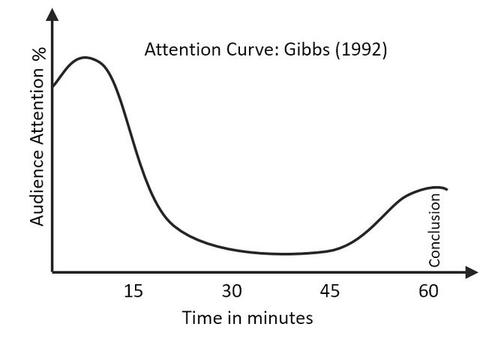
Formative assessment should be frequent: ideally every 5 min, at least every 10-15 min. Indeed, the attention span is 10-15 min and attention should be refocused after that.
Dealing with feedback
Feedback is hard.
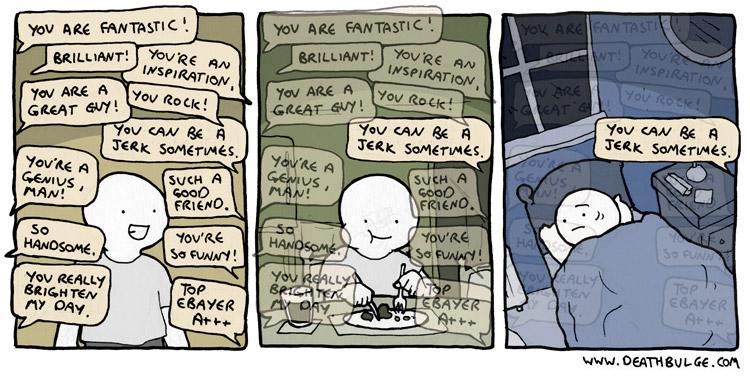
Humans focus more on negative feedback than on positive (you are not alone). How to deal with (bad) feedback received from trainees:
- Breath deeply
- Try to see the point in the criticism, learn from it
- Don’t take it personally
Trainees feedback should be considered along other forms of quality evidence:
- Review what they have effectively learned (in exams)
- Consider your own experience of teaching
- Discuss with colleagues and friends
- Look at the feedback from past sessions of the same course
- Look at the response rates
- Look at the counter examples (contradictions)
- Look at the repetitive patterns (not at only one single answer)

Conclusions
Key points
Formative assessment should be frequent
Feedback is hard
Frequently Asked Questions
Have questions about this tutorial? Check out the FAQ page for the Teaching and Hosting Galaxy training topic to see if your question is listed there. If not, please ask your question on the GTN Gitter Channel or the Galaxy Help ForumQuizzes
Check your understanding with these quizzes
Collecting formative assessment
- Self Study Mode - do the quiz at your own pace, to check your understanding.
- Classroom Mode - do the quiz synchronously with a classroom of students.
How to integrate the result of formative assessment / feedback in your course?
- Self Study Mode - do the quiz at your own pace, to check your understanding.
- Classroom Mode - do the quiz synchronously with a classroom of students.
How frequent should formative feedback be?
- Self Study Mode - do the quiz at your own pace, to check your understanding.
- Classroom Mode - do the quiz synchronously with a classroom of students.
Diagnostic Assessment
- Self Study Mode - do the quiz at your own pace, to check your understanding.
- Classroom Mode - do the quiz synchronously with a classroom of students.
References
- Nicholls, G., 2002 Developing teaching and learning in higher education. Routledge.
- Via, A., P. M. Palagi, J. M. Lindvall, R. E. Tractenberg, T. K. Attwood et al., 2020 Course design: Considerations for trainers–a Professional Guide. F1000Research 9:
Feedback
Did you use this material as an instructor? Feel free to give us feedback on how it went.
Did you use this material as a learner or student? Click the form below to leave feedback.
Citing this Tutorial
-

Bérénice Batut , 2022 Assessment and feedback in training and teachings (Galaxy Training Materials). https://training.galaxyproject.org/training-material/topics/teaching/tutorials/assessment/tutorial.html Online; accessed TODAY
- Batut et al., 2018 Community-Driven Data Analysis Training for Biology Cell Systems 10.1016/j.cels.2018.05.012
@misc{teaching-assessment, author = "Bérénice Batut and Fotis E. Psomopoulos and Allegra Via and Patricia Palagi and ELIXIR Goblet Train the Trainers", title = "Assessment and feedback in training and teachings (Galaxy Training Materials)", year = "2022", month = "10", day = "18" url = "\url{https://training.galaxyproject.org/training-material/topics/teaching/tutorials/assessment/tutorial.html}", note = "[Online; accessed TODAY]" } @article{Batut_2018, doi = {10.1016/j.cels.2018.05.012}, url = {https://doi.org/10.1016%2Fj.cels.2018.05.012}, year = 2018, month = {jun}, publisher = {Elsevier {BV}}, volume = {6}, number = {6}, pages = {752--758.e1}, author = {B{\'{e}}r{\'{e}}nice Batut and Saskia Hiltemann and Andrea Bagnacani and Dannon Baker and Vivek Bhardwaj and Clemens Blank and Anthony Bretaudeau and Loraine Brillet-Gu{\'{e}}guen and Martin {\v{C}}ech and John Chilton and Dave Clements and Olivia Doppelt-Azeroual and Anika Erxleben and Mallory Ann Freeberg and Simon Gladman and Youri Hoogstrate and Hans-Rudolf Hotz and Torsten Houwaart and Pratik Jagtap and Delphine Larivi{\`{e}}re and Gildas Le Corguill{\'{e}} and Thomas Manke and Fabien Mareuil and Fidel Ram{\'{\i}}rez and Devon Ryan and Florian Christoph Sigloch and Nicola Soranzo and Joachim Wolff and Pavankumar Videm and Markus Wolfien and Aisanjiang Wubuli and Dilmurat Yusuf and James Taylor and Rolf Backofen and Anton Nekrutenko and Björn Grüning}, title = {Community-Driven Data Analysis Training for Biology}, journal = {Cell Systems} }
Funding
These individuals or organisations provided funding support for the development of this resource
This project (2020-1-NL01-KA203-064717) is funded with the support of the Erasmus+ programme of the European Union. Their funding has supported a large number of tutorials within the GTN across a wide array of topics.

 Questions:
Questions:

